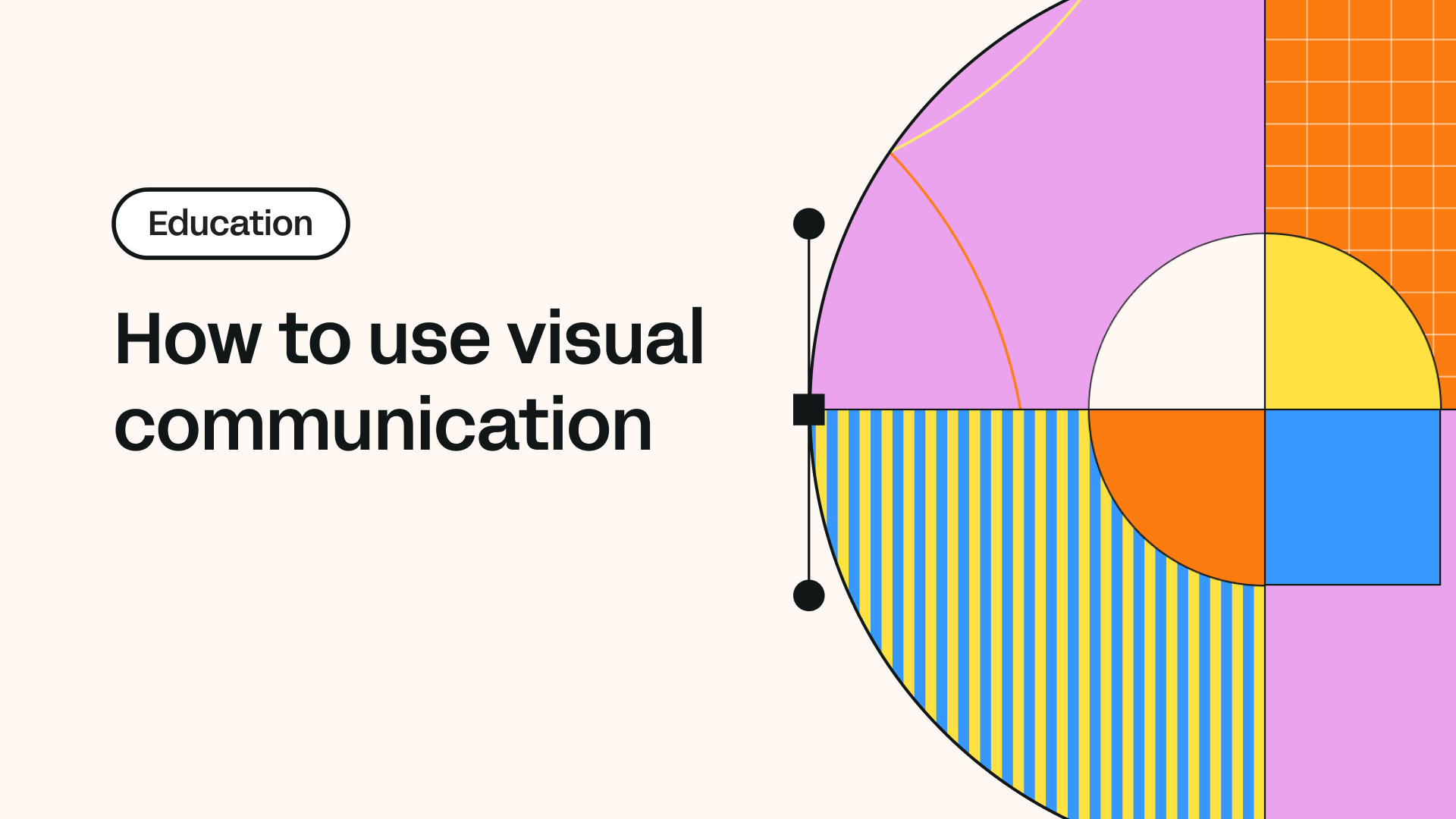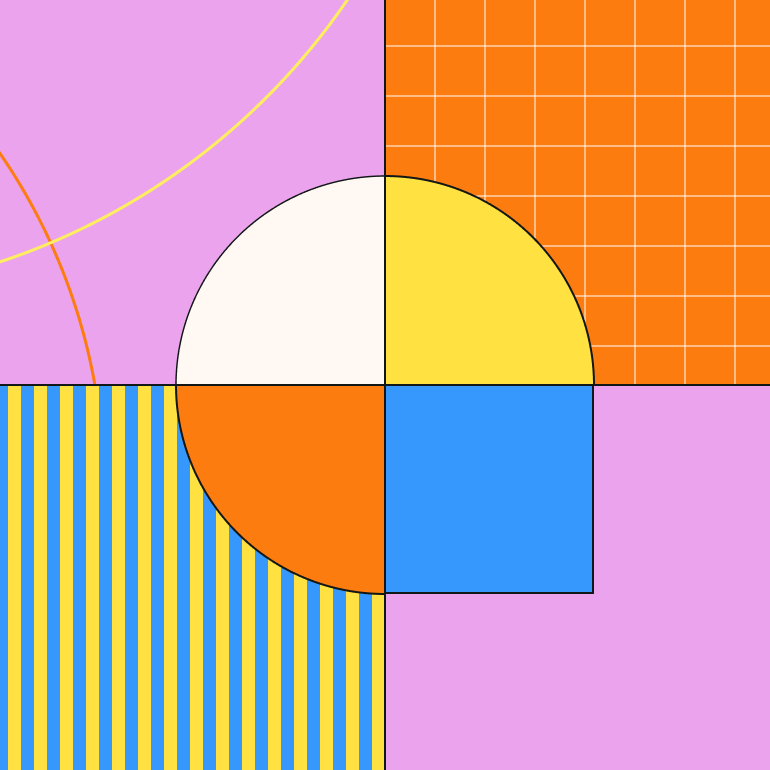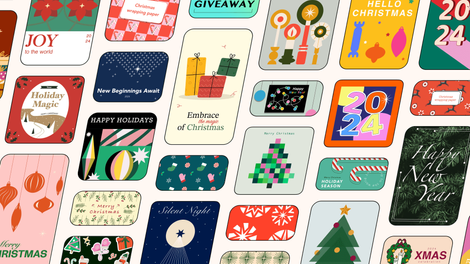Think about a can of Coca-Cola. How do you picture it?
The white letters stand out against the vibrant red background to form the brand's name, creating an unmistakable image that in many cases evokes memories of happiness, such as a summer spent with friends or a holiday celebrated with the family.
The way Coca-Cola communicates its values through images, videos, and colors is just one of many successful examples of visual communication. This concept is growing more important every year and is now essential for the success of all types and sizes of companies.
Jumpstart your ideas with Linearity Curve
Take your designs to the next level.
Whether you want to reach a vast audience of potential customers or instruct your in-house teams, understanding how to use visuals to support your message is imperative. Interested in learning more? In this guide, we'll answer:
- What is visual communication?
- What are the semiotics behind visual communication?
- Why is it important?
- The best examples of visual communication;
- The 3 best tips on how to use visual communication;
- How to find a job in visual communication?
What is visual communication?
Visual communication refers to the practice of using various graphic elements to convey a message clearly, causing a particular kind of impact on the audience. It is an attempt to graphically represent a piece of information, be it explicit or implicit.
Different content formats can be used in this process, from simple images to interactive infographics. With the insertion of resources such as shapes, icons, diagrams, charts, and more, a company can help the audience understand the message and direct their emotional reaction.
For example, the use of vibrant colors, such as red and yellow, is associated with positive emotions, such as happiness and vitality.
It is no wonder it is predominant in the products and advertisement pieces of companies that have as their marketing strategy the brand's humanization and the creation of close relationships with consumers. Several fast-food chains serve as examples.

In addition to branding-related actions, visual communication is also a key element in other areas of marketing, such as content creation. Infographics are excellent examples of materials that mix graphic resources with text in order to create a unique, informative experience for readers.
In companies' internal environment, knowing how to communicate visually is also fundamental to ensure the team's alignment. Presentations and reports, for example, become much richer and easier to understand when composed of graphics and other visual elements.
What are the semiotics behind visual communication?
If you want to take your communication skills to the next level, you need to be familiar with the concept of visual semiotics. It is a subfield of semiotics aimed at understanding how images convey meaning to those who see them. Put simply, it is the study of signs and symbols that we can see.
This concept's role in visual communication strategies is quite large since it helps the company ensure their persona understands the message it is trying to pass on.
If your target is a consumer, visual semiotics can make a difference in their buying decision. In internal teams, this concept is used to strengthen the organizational culture, reinforcing, for example, its visual identity.

Why do visual semiotics matter?
The study of visual semiotics is vital in the effort to convey the proper message to the audience. One of the leading theorists in the field, Swiss linguist Ferdinand Saussure, believes signs can basically be interpreted in various ways to different people.
Knowing how to influence this interpretation is critical to the success of your strategy.
So semiotics is but another element to add to your visual communication strategy in order to make it more effective. If successful in this endeavor, your business will stand out in the way it engages its audience, gaining relevance and authority in the market.
Unlock the Power of Visual Semiotics in Design
Understand the deep impact of visual symbols and signs in communication. Dive into our resources to learn how visual semiotics can enhance your design strategy.
When we think of Digital Marketing, for example, visual resources are indispensable even to attract the customer's attention in the first place. With so much content being created every day, it is hard to attract users, whose attention span gets shorter year by year. There is no way texts are enough.
Moreover, various data corroborate the superiority of strategies that use visuals to attract users' attention or educate an audience. One of the reasons is purely scientific: the human eye processes visual messages much faster than processes texts.

Strengthening your visual communication also means solidifying your brand identity. Using colors, icons, and other graphic elements that relate to your brand helps consumers form an idea about you, leading to conversions.
Finally, it is important to emphasize the flexibility offered by visual communication. Certain messages, especially those involving more complex data, are difficult to communicate.
However, videos, images, and other resources make this job much more manageable. No wonder more and more companies are investing in data visualization.
The best examples of visual communication
There are different types of elements that you can use to enrich your visual communication. We will talk about some of them below.
Images
Pictures are worth a thousand words. The saying may be old, but it remains true. Inserting images in your materials, from blogposts to eBooks, is key to attracting the audience's attention. Also, with a good SEO strategy, images can boost your ranking in Google.
.gif
The .gif format is usually reserved for more informal channels, such as social media and, depending on their characteristics, blogs. They are motion images, which are often associated with memes and internet forums. Their use, however, can also have educational purposes.
This one, for example, helps to visualize the value of pi.

Illustrations
Using illustrations is an excellent way to humanize your brand by associating it with a more relatable look to the consumer. The significant advantage here is creative freedom, enabling the designers to explore different elements and create the perfect illustration.
This format is often used for the creation of infographics. Below is material developed by Hired, Inc. to connect with tech workers.

Animations
Animated content is much more attractive to the consumer than static material. Animations are basically moving illustrations and are also distinguished by creative freedom. They can be used to educate the audience, present a new product, or simply reach out to the public.
During the most critical period of the pandemic, several organizations released animations intended to help prevent the spread of the virus. Check out an example below.
The 3 best tips on how to use visual communication
The most effective communication strategy will vary according to the characteristics of the company, such as the professionals it has at its disposal and the goals it wants to achieve. Naturally, companies with access to quality talent and advanced resources will have an easier time succeeding in this area.
However, by following a few basic tips, it is possible to develop a strategy that fits in your company's pocket and ambitions. Here are 3 indispensable pieces of advice.
Know your audience
Every communication strategy must focus on the message's recipient. You must tailor your efforts to the needs and motivations of your target audience. Otherwise, you will never get their attention. Therefore, the first step in developing your visual communication is to establish a persona.
This semi-fictitious character will serve as a guide for you to make decisions during your content production. The idea is to use the most appropriate resources and triggers to attract and retain the audience's attention, as well as facilitate their understanding.
Get creative with our ready-to-use templates.
Linearity Curve offers templates for every social media platform and various use case templates for posters, business cards, slides, app store screenshots, and more.
Be consistent with your identity
Remember when we mentioned the Coca-Cola can and its striking colors? Can you imagine the brand launching products or advertising pieces with other dominant colors? Probably not, right?
This is because the American multinational recognizes the importance of maintaining consistency with the brand identity.
This does not only concern colors, but all visual elements included in a content or document. An excellent example comes from Apple. The Silicon Valley company, known for its minimalist design, keeps its visual identity consistent even in internal presentations, such as this one directed to its employees.
Value quality
Quality is critical when we talk about visual communications. More than creativity, you need to have the means to produce materials with the quality your audience demands. So after defining your persona and visual identity, start looking for ways to access top resources and professionals.
How to find a job in visual communication?
Thinking about finding a job in the visual communications market? It's only natural, since this is an area that shows strong signs of growth in the mid and long-term.
The good news is that although it is a crowded industry, you can fill a wide variety of positions.
Graphic design
Graphic designers, for example, are responsible for creating the majority of visual products for a company. This includes logos, infographics, flyers, images for social media, etc.
They are not, however, responsible for taking care of the space where these elements will be displayed.
Web design
For this reason, another very sought-after expert in the visual communication market is the web designer. Combining colors, text, and graphics, this professional takes care of platforms such as websites, ensuring rich and intuitive experiences for visitors.
Multimedia
It is also possible to specialize in producing a specific type of content. Photographers, videographers and video editors are important roles for any kind of visual production.
Design leads
In addition, of course, there are leadership positions. Art directors, for example, are responsible for overseeing the work of graphic and web designers.
Wrap up
Visual communication is the practice of using graphic resources to facilitate the transmission of ideas. Using various elements and formats makes it possible to create positive experiences for the audience, fostering their understanding and strengthening the brand's image.
Now, what visual communication practices interest you the most? Do you already apply them in your routine? Leave a comment and let us know.
We also invite you to try Linearity Curve (formerly Vectornator) for all your visual communication needs. Whether it's designing an eye-catching poster or putting together a sleek slide deck, Linearity Curve has the tools and templates to take your ideas further.
Jumpstart your ideas with Linearity Curve
Take your designs to the next level.


Share this!
Ben Barnhart
Ben is the Marketing Manager at Linearity in Berlin, with extensive experience in content writing. He blends his passion for animation and history to develop impactful marketing strategies.





:quality(75))




